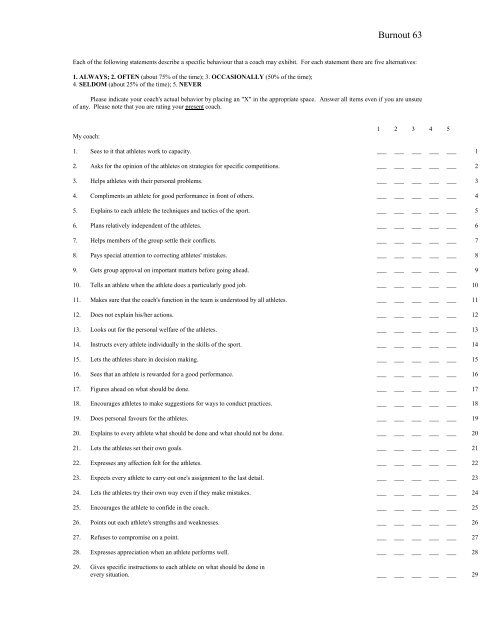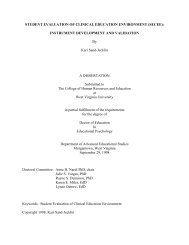Coach and Athlete Burnout - West Virginia University
Coach and Athlete Burnout - West Virginia University
Coach and Athlete Burnout - West Virginia University
Create successful ePaper yourself
Turn your PDF publications into a flip-book with our unique Google optimized e-Paper software.
<strong>Burnout</strong> 63<br />
Each of the following statements describe a specific behaviour that a coach may exhibit. For each statement there are five alternatives:<br />
1. ALWAYS; 2. OFTEN (about 75% of the time); 3. OCCASIONALLY (50% of the time);<br />
4. SELDOM (about 25% of the time); 5. NEVER<br />
Please indicate your coach's actual behavior by placing an "X" in the appropriate space. Answer all items even if you are unsure<br />
of any. Please note that you are rating your present coach.<br />
My coach:<br />
1 2 3 4 5<br />
1. Sees to it that athletes work to capacity. ___ ___ ___ ___ ___ 1<br />
2. Asks for the opinion of the athletes on strategies for specific competitions. ___ ___ ___ ___ ___ 2<br />
3. Helps athletes with their personal problems. ___ ___ ___ ___ ___ 3<br />
4. Compliments an athlete for good performance in front of others. ___ ___ ___ ___ ___ 4<br />
5. Explains to each athlete the techniques <strong>and</strong> tactics of the sport. ___ ___ ___ ___ ___ 5<br />
6. Plans relatively independent of the athletes. ___ ___ ___ ___ ___ 6<br />
7. Helps members of the group settle their conflicts. ___ ___ ___ ___ ___ 7<br />
8. Pays special attention to correcting athletes' mistakes. ___ ___ ___ ___ ___ 8<br />
9. Gets group approval on important matters before going ahead. ___ ___ ___ ___ ___ 9<br />
10. Tells an athlete when the athlete does a particularly good job. ___ ___ ___ ___ ___ 10<br />
11. Makes sure that the coach's function in the team is understood by all athletes. ___ ___ ___ ___ ___ 11<br />
12. Does not explain his/her actions. ___ ___ ___ ___ ___ 12<br />
13. Looks out for the personal welfare of the athletes. ___ ___ ___ ___ ___ 13<br />
14. Instructs every athlete individually in the skills of the sport. ___ ___ ___ ___ ___ 14<br />
15. Lets the athletes share in decision making. ___ ___ ___ ___ ___ 15<br />
16. Sees that an athlete is rewarded for a good performance. ___ ___ ___ ___ ___ 16<br />
17. Figures ahead on what should be done. ___ ___ ___ ___ ___ 17<br />
18. Encourages athletes to make suggestions for ways to conduct practices. ___ ___ ___ ___ ___ 18<br />
19. Does personal favours for the athletes. ___ ___ ___ ___ ___ 19<br />
20. Explains to every athlete what should be done <strong>and</strong> what should not be done. ___ ___ ___ ___ ___ 20<br />
21. Lets the athletes set their own goals. ___ ___ ___ ___ ___ 21<br />
22. Expresses any affection felt for the athletes. ___ ___ ___ ___ ___ 22<br />
23. Expects every athlete to carry out one's assignment to the last detail. ___ ___ ___ ___ ___ 23<br />
24. Lets the athletes try their own way even if they make mistakes. ___ ___ ___ ___ ___ 24<br />
25. Encourages the athlete to confide in the coach. ___ ___ ___ ___ ___ 25<br />
26. Points out each athlete's strengths <strong>and</strong> weaknesses. ___ ___ ___ ___ ___ 26<br />
27. Refuses to compromise on a point. ___ ___ ___ ___ ___ 27<br />
28. Expresses appreciation when an athlete performs well. ___ ___ ___ ___ ___ 28<br />
29. Gives specific instructions to each athlete on what should be done in<br />
every situation. ___ ___ ___ ___ ___ 29












